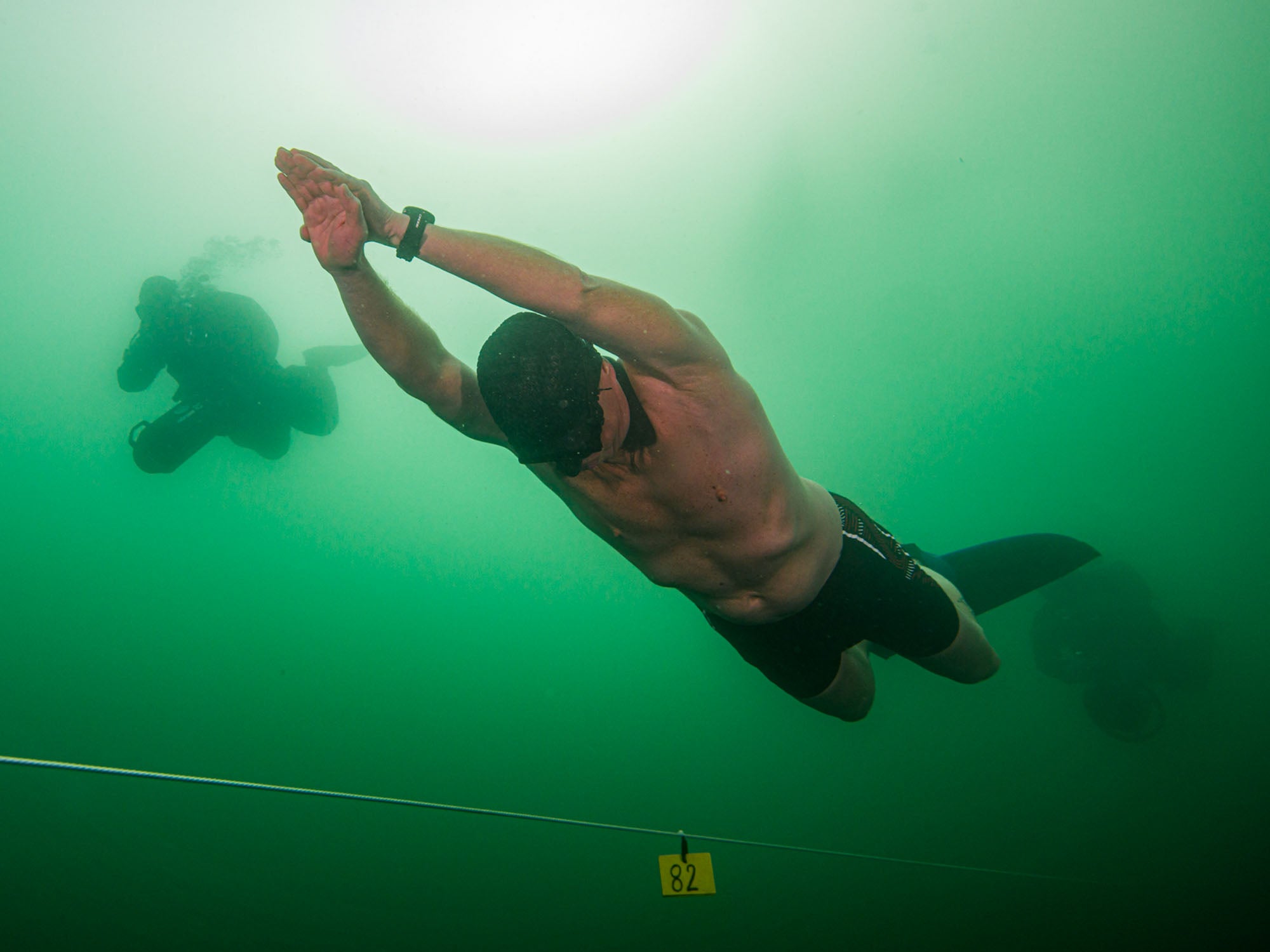Story by Bill Hawthorne
All photos © 2024 Bill Hathorne
Florida’s springs captivate a wide audience. Their clear waters, abundant fish and wildlife, and variable nature makes them ideal destinations for relaxation, fishing, scuba diving, snorkeling, and more. But there is a side to springs that most people never get to see. When the sun retires, a whole new ecosystem is born in the darkness. As fish go to sleep, their prey emerge from the grasses. As humans exit the waters, alligators regain dominance. Species that many people never knew existed, enjoy the protection of a dark sky.
I have been enjoying the spoils of Florida’s springs for around 6 years, with a good portion of that time working in their waters as a biologist. It was only last year that I began to explore these springs at nighttime. My good friend and excellent photographer Joseph Ricketts (@josephrickettsphoto) invited me out to paddle down a spring fed river at night. We would leave at 9pm and return around 4am. This sounded exhausting and kind of scary, but my doubts made me want to embark even more.
Launching into the Darkness
We launched our canoe and set off. The main river was dark and quiet. Tannins from surrounding trees stained the water brown. The only light came from the stars. The river was so still; you could see the reflection of the stars in her waters. Soon, we were paddling through space.
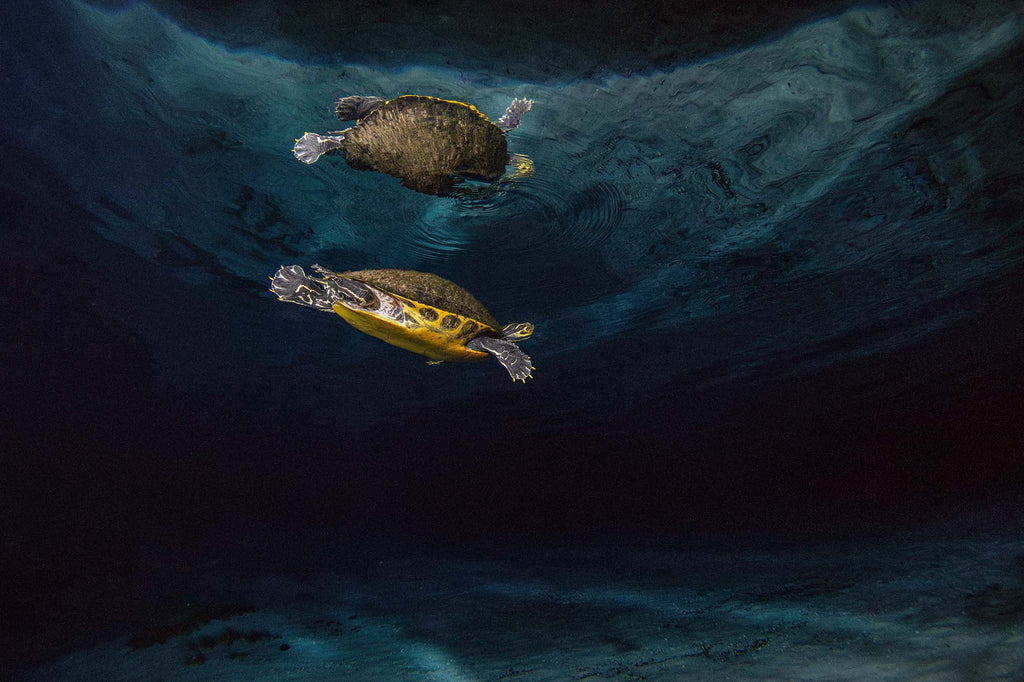
A Suwannee Cooter floats peacefully after taking a much-needed breath from the surface.
After an hour, we arrived at our first stop. A small spring that poured crystal clear water into the brown water of the river. Looking down from the side of the canoe, you could see all the life. Fish were attracted to the lights, snakes slithered through the emergent grasses, alligators floated like logs and turtles zoomed by like UFO’s.
There were no people, no insects, not a sound except for the occasional grunts as we struggled into our wetsuits. After much struggle, we entered the water. Suddenly... noise. I am not sure what I was expecting, snorkeling in a spring at night, but I was certainly not expecting to be most surprised by the noise. It was a crackling sound, like throwing wet pine on a dying fire. It was loud and constant; it immediately ignited my curiosity. I began to look around and what I saw shocked me. I was expecting a quiet, peaceful version of the daytime springs – what I saw was quite the opposite. I entered in the middle of a battlefield. Bass were hammering minnows. Minnows were crushing crustaceans. Crayfish were perusing the battlefield and clearing the carcasses. It was chaos. I was looking forward to a quiet evening, but I realized quickly that the food chain takes no breaks. The dark waters provide shelter for many animals, but some predators evolved to take advantage of this.
A Whole New Ecosystem?
Since that night, Joseph and I have completed many more nighttime missions. Apart from the noise, something else stood out to me. The assemblage and diversity of animals completely changes at night. I would like to say it is a whole different ecosystem, but in reality, it is just a part of the system we never see. It would be like seeing New York City during the day, wondering how all of the chaos can possibly remain in balance, without noticing the street cleaning, garbage men, road workers, and business owners that return the order in the night.
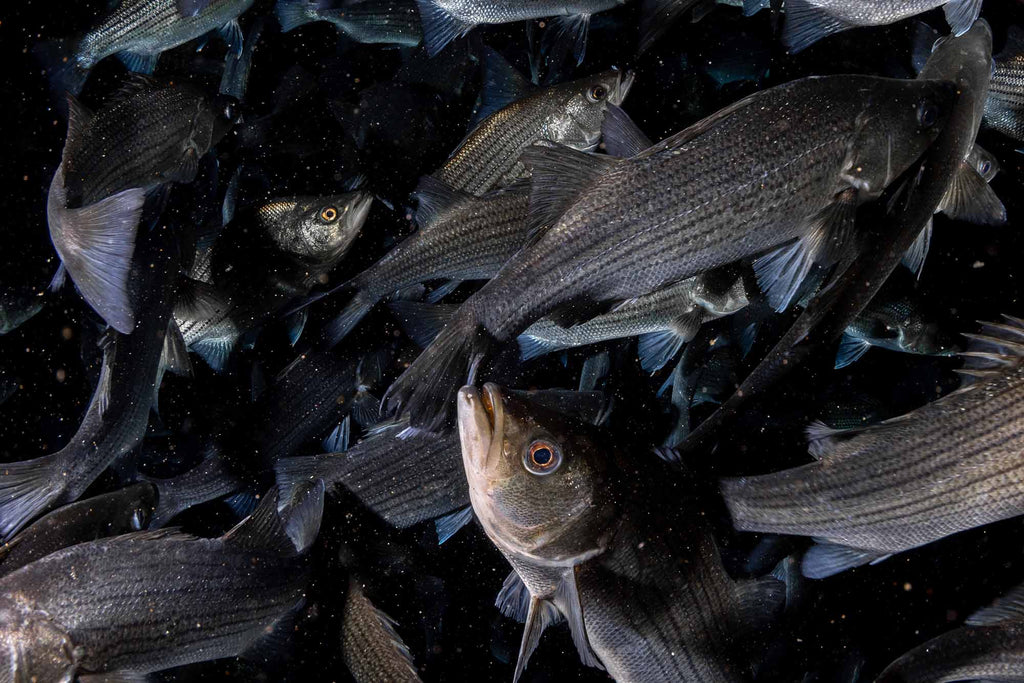
A Sunshine Bass battlefield. At night, their prey emerge and the bass feast. Many people know that manatees seek Florida’s springs during the winter for the warm waters. Not many people know that Sunshine Bass seek Florida’s springs during the summer for the cool waters. Without access to springs, Florida likely wouldn’t be home to either of these species.
We saw many animals that most people may never have the pleasure of laying eyes on. Salamanders over three feet long hunt along the murky bottom. Shrimp, the size of lobsters, scour the bottom for leftover delights. American Eels exit their daytime burrows, searching for their next meal. These animals have some of the most unique ecologies of any freshwater organisms and they are so rarely encountered. After millions of years of evolution, they found unexploited niches in the dark of the night. They adapted to navigate in little to no light and hunt prey with pinpoint accuracy. What you need to survive the night is often very different than what you need to survive the day. This selection has led to an incredible diversity of unique, interesting animals that call the dark their day.
Giant Freshwater Shrimp
The Big Claw River Shrimp is an animal that I didn’t know existed until I stumbled upon the molted body of one in a spring. Immediately, I became obsessed. A giant, freshwater shrimp... how big? They can grow to over a foot long; if you include the claws, their total size can be double that. How had I never heard of these? Surely, a giant shrimp would be a delicacy at most restaurants.

A 3-foot-long Greater Siren Salamander explores the bottom of a Florida Spring while Joseph Ricketts prepares his camera. Most salamanders begin their life in the water then morph into a more terrestrial stage. These salamanders stay underwater their entire lives, retaining a beautiful pair of external gills.
Turns out, they tried farming these animals before, but ran into too many issues with cannibalism. These giant shrimps are as mean as they look and will defend their territories fiercely. But there is a gentler, more affectionate side to these shrimps as well. Every year, they travel many miles to spawn. Although they live in freshwater, they exclusively lay eggs in salt or brackish water. These great migrations can be over a hundred miles long, last for months, and consist of hundreds of thousands of individuals. They have occurred for millions of years, but the recent implementation of dams has blocked these great migration routes and diminished the populations of Big Claw River Shrimp. Thankfully, there is a strong movement to remove dams across the United States. Hopefully, Florida will follow suit and allow our great rivers to flow free once more.
Sea Cows at Play
Manatees are frequent visitors of Florida’s freshwater springs. The first time I snorkeled with manatees at night, I was expecting to see large herds sleeping. I was surprised to see that they pretty much acted the same as during the day. As always, they spent a lot of time sleeping, but they also spent a lot of time exploring.
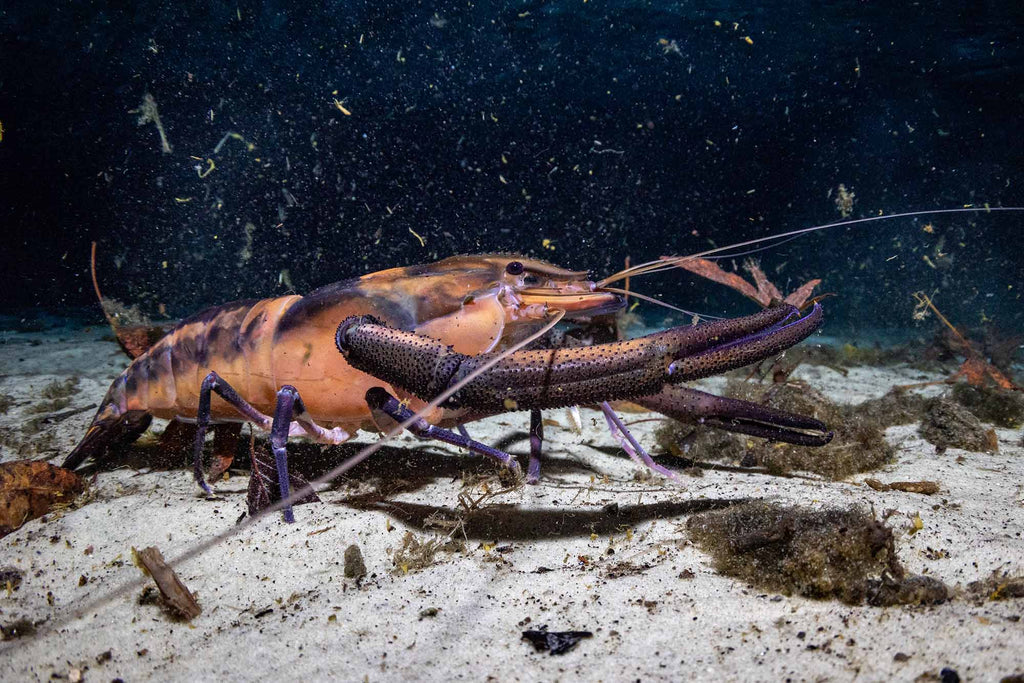
A Big Claw River Shrimp marches his way across the sandy bottom of a Florida Spring. These shrimp are the largest freshwater invertebrates in North America. They make tremendous migrations and are incredibly territorial.
One night, I was photographing a small American Eel when my leg was suddenly grabbed – I was so scared, I nearly jumped out of my wetsuit. My immediate thought was alligator, but I turned around and it was just a manatee investigating my legs (maybe he was jealous?). They are incredibly inquisitive animals, and I am confident they are far more intelligent than they may seem – their closest relatives are elephants after all.
Despite their bulbous appearance, manatees don’t have blubber and therefore have to seek warm water refuges when the oceans cool during the winter. Springs have (or were) the perfect refuge. At a pleasant 72ºF (22C) all year-round, springs once provided the warmth and food that manatees need to make it through the winter. In recent years however, nitrogen pollution from fertilizer, agriculture, and improper wastewater management has killed off the vegetation in many springs. Now, many manatees are faced with an impossible choice. Brace the cold or stay warm and starve.
Fastest Jaws in the South
I would be remiss writing a story about springs at night if I didn’t talk about the American Alligator. One of the most feared and revered animals in the states. Whenever I mention that I am a freshwater photographer in Florida, people always ask me about the alligators.
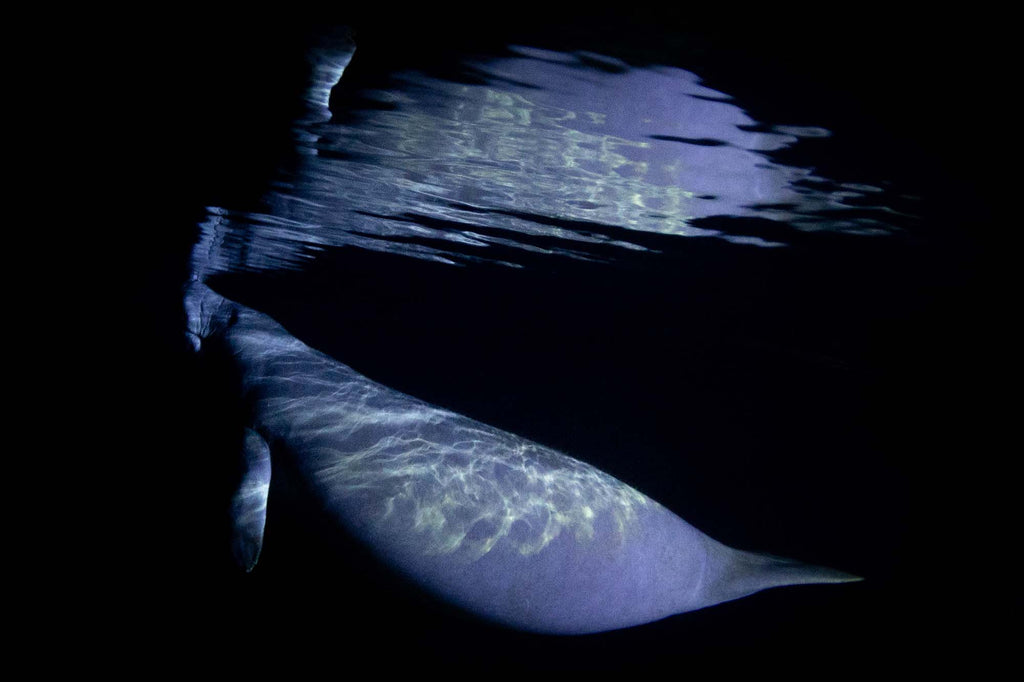
A manatee takes a breath at night. Their large size can be quite intimidating but their calm and gentle nature quickly diminishes any worries – except when they sneak up from behind and grab you! I wanted to highlight their gentle nature with this photograph. I am very pleased how the side lighting created dark shadows and reflected the ripples of the water surface onto the manatees back.
The truth is, they are not as blood thirsty as most people think. During the day, most alligators shy away from swimmers. They don’t enjoy the noise, and associate people with danger. At night however, alligators are much more confident. They leave their dens and search for their meals. Probably from the media, most people think alligators only eat deer and people, I think almost everyone would be surprised to learn that their main food source is crayfish.
Observing springs at night aids in understanding the balance of the ecosystem. As someone who studies these systems for a living, it allowed me to appreciate the constant cycles that occur. Predators and prey alike find ways to take advantage of the dark; forming a system that functions differently than the day. These night snorkels are a way to see the ecosystem as a whole and bring a new excitement to exploration. They highlight the struggle of the food chain and illuminate the issues from the Anthropocene. There is much to explore in these freshwaters. All one has to do is take the plunge.

A large American Alligator floats peacefully at the edge of a Florida spring. These great reptiles have been forced out of many springs by people – at night, they regain control.
Additional Reading
Planning a Trip to Photograph Manatees in Crystal River, Florida
Shooting Florida Gators with Shawn Jackson
An Insider's Guide to Diving the Blue Heron Bridge, Florida
Featured Customers | Bill Hawthorne The Turtles of Florida
Uncovering the Unexpected with the Florida Manta Project
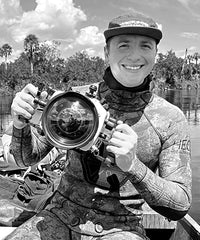
Bill Hawthorne is an aquatic ecologist specializing in the study of the freshwater springs of Florida. Bill focuses his studies and photography on freshwater species, most notably turtles. By sharing his underwater images, Bill hopes he'll expand his viewers' passion toward these unique environments and animals. Check out more of his work on his website, Instagram @billhawthornephotography, TikTok, and YouTube.











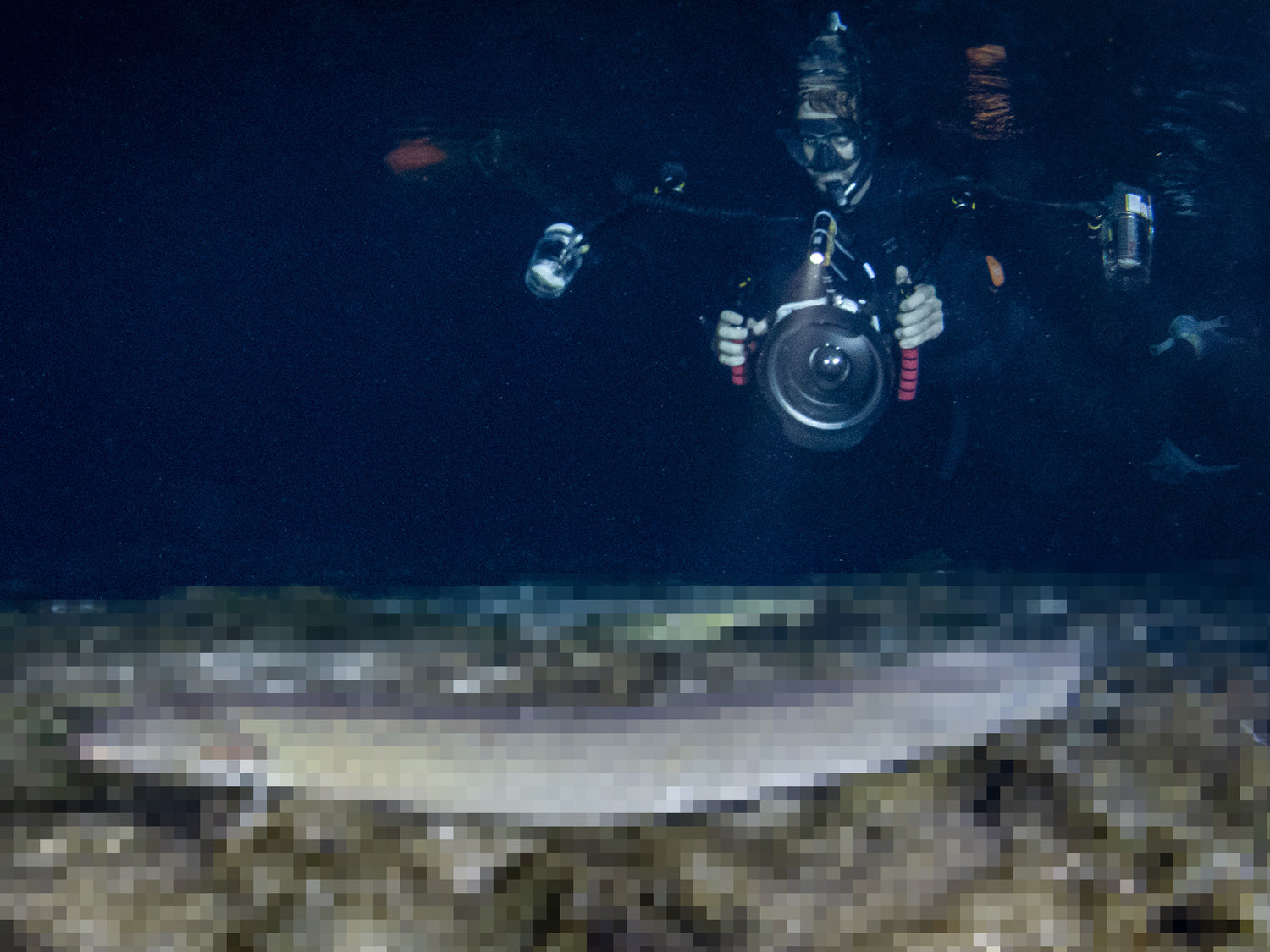
![Photographing Manatees Underwater in Crystal River, Florida [VIDEO]](http://www.ikelite.com/cdn/shop/articles/photographing-manatees-crystal-river-cover.jpg?v=1709864800&width=2000)
